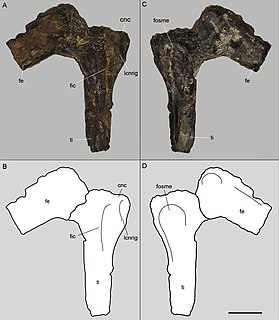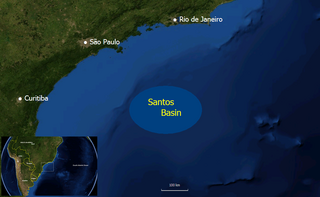 W
WTupi–Guarani is the name of the most widely distributed subfamily of the Tupian languages of South America. It includes fifty languages, including the best-known languages of the family, Guarani and Old Tupi.
 W
WAratasaurus is a monotypic genus of basal coelurosaurian theropod which includes a single species, Aratasaurus museunacionali, known from fossils found in deposits of the Romualdo Formation in Brazil. Aratasaurus lived during the Albian stage of the Early Cretaceous.
 W
WThe Guabirotuba Formation is a late Middle Eocene geologic formation of the Curitiba Basin in Paraná, Brazil. The formation crops out in and around the city of Curitiba and comprises mudstones and sandstones deposited in a fluvial floodplain environment.
 W
WThe Guaratiba Group is a geological group of the Santos Basin offshore of the Brazilian states of Rio de Janeiro, São Paulo, Paraná and Santa Catarina. The group forms the pre-salt layer in the petroleum-rich basin and hosts the biggest oil fields of Brazil, as Tupi, Júpiter and many more. The group contains, depending on the definition, three to four formations and dates to the Early Cretaceous period; Hauterivian to Early Aptian epochs. The total thickness of the group, representing the first phase of sedimentation after the break-up of Gondwana in the Santos Basin, is estimated at 4,200 metres (13,800 ft).
 W
WThe Guarujá Formation is a geological formation of the Santos Basin offshore of the Brazilian states of Rio de Janeiro, São Paulo, Paraná and Santa Catarina. The predominantly calcarenite formation with marls dates to the Early Cretaceous period; Early Albian epoch and has a maximum thickness of 2,500 metres (8,200 ft). The formation is the second-most important post-salt reservoir rock of the Santos Basin.
 W
WIara oil field is a large ultra-deepwater pre-salt oil field located in the Santos Basin, 230 km (140 mi) off the coast of Rio de Janeiro, Brazil, north of Tupi oil field. It covers an area of nearly 300 km2 (120 sq mi).
 W
WThe Iguape Formation is a geological formation of the Santos Basin offshore of the Brazilian states of Rio de Janeiro, São Paulo, Paraná and Santa Catarina. The calcarenite, shale, siltstone, marl and conglomerate formation dates to the Tertiary period and has a maximum thickness of 2,200 metres (7,200 ft).
 W
WThe Ipubi Formation is the middle geological formation of the Santana Group, the middle part of the Araripe Group, in the Araripe Basin of northeastern Brazil. The formation is dated to the Aptian to Albian stages of the Early Cretaceous, unconformably overlying the Crato Formation and unconformably overlain by the Romualdo Formation, formerly known as the Romualdo Member of the Santana Formation. The averaging 15 metres (49 ft) thick Ipubi Formation comprises shales and sandstones in the lower section and evaporites in the upper part of the formation, deposited in a transgressive to highstand lacustrine environment in the Araripe rift basin.
 W
WIracema is an oil field located in the Santos Basin, 250 km (160 mi) off the coast of Rio de Janeiro, Brazil, 33 km (21 mi) northwest of the giant Tupi oil field. Iracema is the third well drilled in the BM-S-11 block and could be an extension of ultra deep Tupi oil field. The field was previously called Cernambi.
 W
WThe Itaboraí Formation is a highly fossiliferous geologic formation and Lagerstätte of the Itaboraí Basin in Rio de Janeiro, southeastern Brazil. The formation reaching a thickness of 100 metres (330 ft) is the defining unit for the Itaboraian South American land mammal age (SALMA), dating to the Early Eocene, approximately 53 to 50 Ma.
 W
WThe Itaboraian age is a period within the Early Eocene geologic time epoch of the Paleogene, used more specifically with South American land mammal ages (SALMA). It follows the Riochican and precedes the Casamayoran age.
 W
WThe Itajaí-Açu Formation is a geological formation of the Santos Basin offshore of the Brazilian states of Rio de Janeiro, São Paulo, Paraná and Santa Catarina. The predominantly shale with interbedded turbiditic sandstones formation dates to the Late Cretaceous period; Cenomanian-Maastrichtian epochs and has a maximum thickness of 2,000 metres (6,600 ft). The formation is a reservoir rock of the fields in the Santos Basin.
 W
WThe Itanhaém Formation is a geological formation of the Santos Basin offshore of the Brazilian states of Rio de Janeiro, São Paulo, Paraná and Santa Catarina. The predominantly shale formation with marls, siltstones and sandstones dates to the Early Cretaceous period; Early Albian epoch and has a maximum thickness of 1,500 metres (4,900 ft). The formation is the reservoir rock of the Tambaú Field in the Santos Basin.
 W
WThe Juréia Formation is a geological formation of the Santos Basin offshore of the Brazilian states of Rio de Janeiro, São Paulo, Paraná and Santa Catarina. The predominantly shale with interbedded siltstones and fine sandstones formation dates to the Late Cretaceous period; Santonian-Maastrichtian epochs and has a maximum thickness of 2,000 metres (6,600 ft). The formation is a reservoir rock of the Merluza Field, the first discovery in the Santos Basin.
 W
WKaiwá is a Guarani language spoken by about 18,000 Kaiwá people in Brazil in the state of Mato Grosso do Sul and 510 people in northeastern Argentina. Literacy is 5-10% in Kaiwá and 15–25% in Portuguese. Kaiwá proper is 70% lexically similar with the Pai Tavytera language, and its similarity to its linguistic cousin Guaraní, one of the two national-languages of Paraguay alongside the Spanish language, means it is even sometimes considered mutually intelligible.
 W
WThe Marambaia Formation is a geological formation of the Santos Basin offshore of the Brazilian states of Rio de Janeiro, São Paulo, Paraná and Santa Catarina. The predominantly shale and marl formation dates to the Tertiary period and has a maximum thickness of 2,700 metres (8,900 ft). The formation is a seal and reservoir rock of the Atlanta and Oliva Fields in the Santos Basin.
 W
WNhandumirim is a genus of saurischian dinosaur from the Carnian age of Late Triassic Brazil. The type and only species, Nhandumirim waldsangae, is known from a single immature specimen including vertebrae, a chevron, pelvic material, and a hindlimb found in the Santa Maria Formation in Rio Grande do Sul. Nhandumirim is differentiated from other Santa Maria dinosaurs such as Staurikosaurus and Saturnalia on the basis of its more gracile, long-legged proportions and several more specific skeletal features. It also possessed several unique features compared to other early dinosaurs, such as long keels on vertebrae at the base of the tail, a straight metatarsal IV, and a short brevis fossa of the ilium and dorsolateral trochanter of the femur. Several features of the tibia led the describers of the genus and species to consider Nhandumirim waldsangae the earliest theropod, but some analyses in their study offer alternative positions within Saurischia. All subsequent studies considered Nhandumirim an early sauropodomorph, closely-associated with Saturnalia and Chromogisaurus.
 W
WTupi–Guarani is the name of the most widely distributed subfamily of the Tupian languages of South America. It includes fifty languages, including the best-known languages of the family, Guarani and Old Tupi.
 W
WThe Sapinhoá oil field is an oil field located in the southern Brazilian Santos Basin, 310 kilometres (190 mi) off the coast of Rio de Janeiro in a water depth of 7,065 feet (2,153 m). It was discovered in 2008 and originally named Guará field, under development by Petrobras. The oil field is operated by Petrobras and owned by Petrobras (45%) Repsol Sinopec Brazil (25%) and BG Group (30%). The total proven reserves of the Sapinhoá oil field range from 1,100–2,000 million barrels.
 W
WThe Sepetiba Formation is a geological formation of the Santos Basin offshore of the Brazilian states of Rio de Janeiro, São Paulo, Paraná and Santa Catarina. The predominantly coquina formation dates to the Pleistocene period to recent and has a variable but maximum thickness of 570 metres (1,870 ft). The formation is the uppermost unit of the Santos Basin.
 W
WTapejara is a genus of Brazilian pterosaur from the Cretaceous Period. Tapejara crests consisted of a semicircular crest over the snout, and a bony prong which extended back behind the head.
 W
WTeyujagua is an extinct genus of small, probably semi-aquatic archosauromorph reptile that lived in Brazil during the Early Triassic period. The genus contains the type and only known species, T. paradoxa. It is known from a well-preserved skull, and probably resembled a crocodile in appearance. It was an intermediary between the primitive archosauromorphs and the more advanced Archosauriformes, revealing the mosaic evolution of how the key features of the archosauriform skull were acquired. Teyujagua also provides additional support for a two-phase model of archosauriform radiation, with an initial diversification in the Permian followed by a second adaptive radiation in the Early Triassic.
 W
WOld Tupi or classical Tupi is an extinct Tupian language which was spoken by the aboriginal Tupi people of Brazil, mostly those who inhabited coastal regions in South and Southeast Brazil. It belongs to the Tupi–Guarani language family, and has a written history spanning the 16th, 17th, and early 18th centuries. In the early colonial period, Tupi was used as a lingua franca throughout Brazil by Europeans and aboriginal Americans, and had literary usage, but it was later suppressed almost to extinction, leaving only one modern descendant with an appreciable number of speakers, Nheengatu.
 W
WOld Tupi or classical Tupi is an extinct Tupian language which was spoken by the aboriginal Tupi people of Brazil, mostly those who inhabited coastal regions in South and Southeast Brazil. It belongs to the Tupi–Guarani language family, and has a written history spanning the 16th, 17th, and early 18th centuries. In the early colonial period, Tupi was used as a lingua franca throughout Brazil by Europeans and aboriginal Americans, and had literary usage, but it was later suppressed almost to extinction, leaving only one modern descendant with an appreciable number of speakers, Nheengatu.